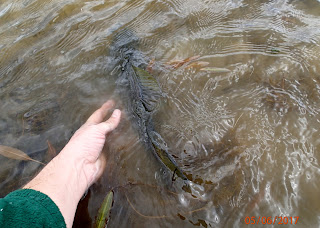I hiked around most of the lower edge of the lake to reach a stretch that usually produces in the spring for me before the weed growth gets out of control. I worked the rocky shoreline slowly, giving the new streamer some hard twitches, then letting it fall and "die." Overzealous bluegills were grabbing it by the tail and running with it frequently, and then I finally got the bass strike I had been needing. I had two concerns for this pattern: would it be as weedless as I had hoped, and would it still hook fish consistently. Yes, and yes.
I caught no giants there, but having fish strike this fly and get hooked (I was 2/2 on bass strikes) was a positive sign. On a slow fishing day, the weedless Murdich produced and performed well. After about 90 minutes, I decided to leave the lake for a change of scenery. I headed to the pond looking for over sized hybrid sunfish on my 3wt, which I found in small numbers, but found something else much more memorable.
Late last summer, I had discovered a pond on some public ground near home that was a chore to reach. I bushwhacked through briers, weeds over my head, and spiders to reach the pond. Long story short, I spotted some really nice bass, and eventually lost one that I'm confident would have been my biggest ever on the fly. The fly that hooked that fish was a complex twist bugger-style fly with a Laser Dub head and some rubber legs. Saturday was a different location, but the story started similarly. I spotted a really large bass on the edge of an old spawning bed, but too late and after it spotted me. The big bass was alone, and retreated to the far side of a weed line about 25' away where it slowly "paced" back and forth. It ignored my first two casts with the flashy Murdich, so I switched flies quickly...to the same complex twist fly in a sunfish coloration. I put the fly right in her face, and watched it disappear. The initial run was the strongest I have ever had from a largemouth, and the fish tried to bury itself in the weeds. With steady pressure, I got her out and made a successful first attempt to lip her.
My previous personal best on the fly was 19 1/4", having never topped the 20" plateau. This fish measured right at 21", trophy citation size for the state of Ohio. I snapped a few quick photos, got a rod measurement, and sent her back on her way.
Last summer's loss of that big bass when she dove into a tree top and broke me off still stings, and I feel like I have some unfinished business with the large bass of that secluded pond. Landing this fish, however, relieved some of that sting. I have waited a long time for a bass like this on the fly in Ohio, and it was worth the wait. So next time you see a crummy weather forecast and wonder if it's worth going out, remember that you don't stand a chance at a great fish if you stay home. Until next time!







Great fish! What a cool experience too. Nice!
ReplyDeleteQuestion, why the snap v a loop knot? I never thought to try a snap on a fly, and seeing you doing it makes me think: Why not? Sure faster and easier - saves on tippet too...
I switch flies a lot, and also want the benefits of a loop knot for fly action. Using a snap saves knot-tying time, allows fast fly changes, saves on tippet...basically all of the benefits of a loop knot without having to tie one on every fly change.
Delete